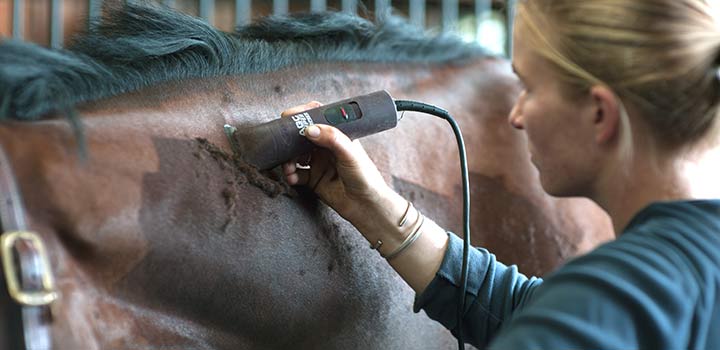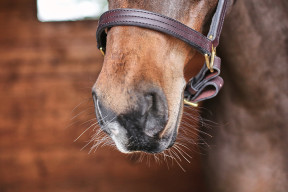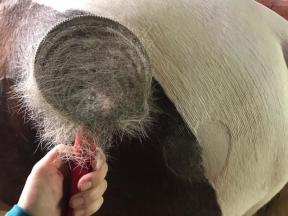SmartPak’s Ultimate Guide to Horse Clipping
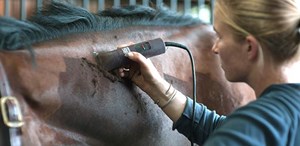
SmartPak’s Ultimate Guide to Horse Clipping
TO CLIP OR NOT TO CLIP?
The decision to clip or not clip your horse depends on a variety of factors – your horse’s living situation and time of year, your horse’s exercise level, as well as any medical or comfort needs.
CLIP IF...
- You or your barn staff can make daily, seasonally appropriate blanket or sheet changes as needed
- Your horse will be ridden and or is sweating on a regular basis
- Your horse has access to a stall for shelter
- Your horse has a condition that makes clipping the right choice for comfort and good hygiene
DON'T CLIP IF...
- Your horse needs to wear the same blanket most of the time, regardless of weather and workload
- Your horse is taking it easy this winter and won't be ridden much
- Your horse is mostly outside in the elements without daily blanketing adjustments or shelter
- Like many things in the horse world, you may find you and your horse’s situation fit into both the “CLIP IF” and “DON’T CLIP IF” categories. We know that your horse’s living environment, management, and your own personal preferences all play a role, too. To help you decide on which is the right choice for your horse, you can ask yourself some key questions:
WHO?
In winter, if you or your barn staff can’t check on your horse at least twice a day to make any necessary blanket changes as temperatures fluctuate, you should step away from the clippers and let your horse do his own thermoregulation. Read our Blanketing Guide, that has a useful blanket chart to help you determine what blanket would be appropriate, based upon your horse and the temperature in your area. Clipping off insulating hair without providing shelter and seasonally appropriate blanketing can be detrimental to your horse’s overall health and wellbeing.
Horses who have metabolic or endocrine challenges – such as Equine Metabolic Syndrome (EMS) or Cushing’s Disease may require body or trace clipping. This is to help them be comfortable, with or without exercise, year-round. Overweight and non-shedding horses may need help regulating their body temperatures, so evaluating if your horse is sweaty or exhibiting signs of being too warm is appropriate and recommended.
Some horses with Anhidrosis, or the inability to sweat, also need assistance in keeping cool in the warmer times of the year. Clipping, in addition to management, can also help keep these horses comfortable.
If showing your horse, be sure to check with your showing and or breed organizations to know if you are allowed to clip or trim your horses face or legs – or any other restrictions you may need to be aware of.
WHAT?
That is, what will your horse be doing? In winter, if he’s taking it easy and not being worked, there’s no real reason to clip (we promise, he’ll look adorable all woolly!). However, if he’s regularly working up a sweat, having less hair will help him cool out quickly and be more comfortable.
In warmer months, take into consideration if your horse has a medical condition, what their workload looks like, and if they are able to cool themselves appropriately. If your horse is sweating and isn’t able to cool himself well, due to a non-shedding coat, or the inability to sweat, clipping can be helpful to remove hair that traps heat and sweat close to the skin.
WHERE?
Geography plays a large part in your decision to clip your horse. Winter weather can be mild or severe in different parts of the country, so where your horse lives is a key factor. If he lives in a heated barn and rarely gets turned out, clip away! If he’s out in the elements 24/7, it’s probably best to leave him unclipped. If he spends his time both indoors and out, choose a more conservative clip and then pair that with the appropriate blanket.
During the warmer months, clipping either the whole body or only select areas can make it easier for your horse to cool down. Remember, if you remove the horse’s ability to protect their skin from sun and insects, insect control such as fly repellents, sheets and masks will be needed. If your horse has white markings, equine sunscreen is recommended to protect the skin that has less hair protection from the sun.
WHEN?
Riders who choose to clip seasonally, just for the winter months, will clip initially sometime around late September or October. If you’re planning on showing through the winter or in the early spring, you may want to clip again later in the fall. When thinking about the latest you can clip your horse in winter/spring, and not affect his spring coat growing in, there is an element of "it depends". Some horses can be clipped as late as March and not have their new spring coat affected, while others will need their last clip to be January or February as their spring coat grows in earlier than other horses.
Once the days start getting longer, the increased sunlight cues your horse to start growing his spring coat, and knowing when your horse started to shed out his coat the previous year can help you to figure out when to give him his final clip.
While some only clip their horses seasonally, some clip their horses year-round for either ease of maintenance, or a medical condition that makes it necessary. When clipping year-round, re-clipping can be done every 2-6 weeks, depending on your desired coat length. If you’re able to blanket and protect your horse on a daily basis against weather and insects, this maybe an option for you.
Back To Top↑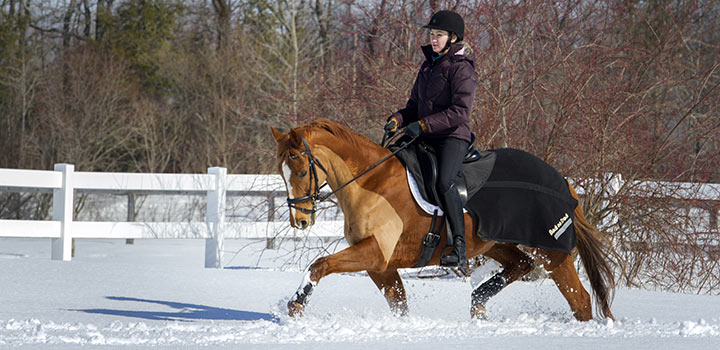
Types of Horse Clips
The right clip pattern for your horse is the clip that suits your horse’s lifestyle and workload. But keep in mind, if you choose any of these body clipping patterns, you’ll be taking away your horse’s natural source of warmth and insect protection, so it’s your responsibility to replace that protection by blanketing or taking appropriate insect control measures depending on the season.
A TRACE CLIP is the most conservative, removing the horse’s coat only in the most sweat-prone areas, including the underside of the neck and chest. It’s a great choice for horses who spend most of the day outside and aren’t ridden heavily and are not sweating a lot.
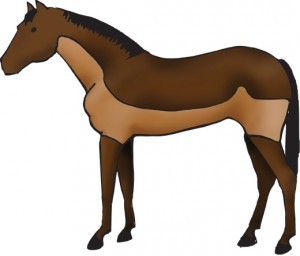
The BLANKET CLIP leaves a “blanket" of hair on the back, which keeps the topline warm and the legs protected but removes hair in sweat-prone areas. This is a great choice for horses who receive regular exercise and also spend time turned out.
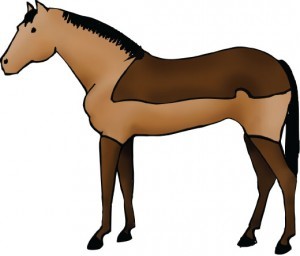
If your horse stays in full work and spends most of his time indoors or in very mild weather, a FULL BODY CLIP is probably your best bet. This clip greatly reduces cooldown time and keeps your horse looking show-ring ready all season long.
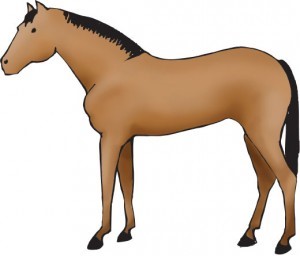 Back To Top↑
Back To Top↑
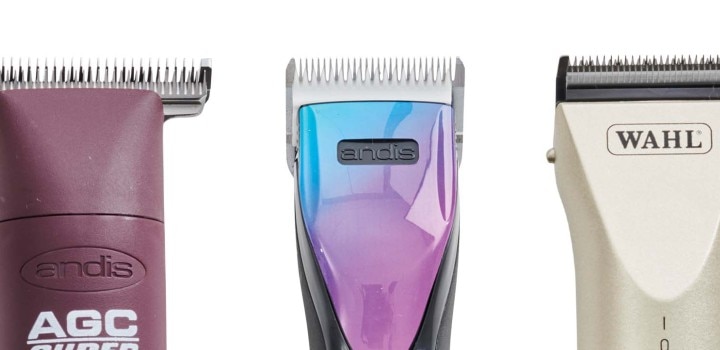
Choosing the Best Horse Clippers
Not all clippers are created equal – we’ll walk you through the different clipper types, what features to consider, and the best clipper for your horse or pony.
There are three types of horse clippers to choose from: trimmers, body clippers, and multi-purpose clippers. Trimmers are made for light-duty areas like your horse’s face, ears, and muzzle, and are available in both corded and battery-operated models. Body Clippers are larger and more powerful – designed to cut through thick coats quickly and easily. Lastly, multi-purpose clippers can be used for multiple areas of the body, and often feature removable clip-on or screw on blades. This allows them to be easily changed, letting you choose the blade length that will best suit your clipping needs.
Consider having more than one type of clipper – as it would not be recommended to use body clippers on a horse’s face or legs – so having a trimmer or smaller multi-purpose clipper for more sensitive body parts can be helpful. Once you’ve decided on a pair of trimmers, multi-purpose clippers and or body clippers, there are a few key features that you can use to narrow down your options further including: noise level, weight, and the type of cord. If you’re concerned that your horse will be sensitive to the noise of clippers, look for a clipper that features a quiet motor.
You’ll also want to consider how much clipping you’re going to be doing. If you’re clipping a barn full of shaggy horses, you’ll want heavy-duty body clippers that can stand up to the job. Body clippers are also recommended for clipping horses with endocrine challenges such as Cushing’s, as they will be able to quickly and efficiently cut through thick and non-shedding coats. If you’re only doing a trace clip on one horse with a normal coat, you’ll likely be able to get away with a lighter-duty, multi-purpose clipper.
Finally, you’ll want to decide whether you need your clippers to be cordless or not. Cordless clippers for horses are generally quiet, easy to hold, and powered by batteries, making them a logical choice for nervous horses. Look for a lightweight, low vibration model – your wrists will thank you later! Also consider purchasing extra batteries so you have one ready to use when your battery needs to be recharged.
Ready to start shopping? Check out our selection of clippers, as well as our cordless clipper options. Want to learn more about choosing the right blades? Keep reading!
Shop All Clippers Back To Top↑
Choosing the Right Horse Clipper Blades
We’ll walk you through it, by the numbers
Body clippers require specific blades to match each individual clipper, so be sure to check and match the brand when purchasing blades. Multi-purpose clippers also should use the same brand of blades, which ensures that they attach and function correctly with the clipper body. For trimmers, it is common to see blades that are screwed into the clipper, and the length is either a set length, or adjustable with a dial. In general, the lower the blade number, the longer the hair will be when you clip. Choose your blade number based on how short you want the hair to be.
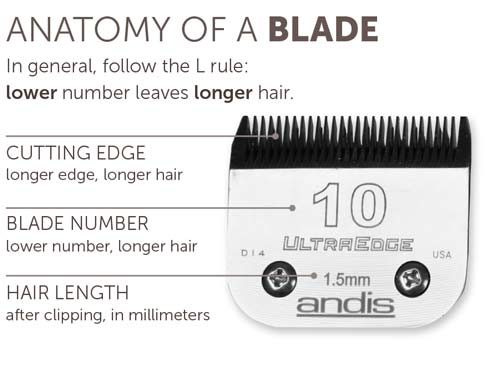
Here are the most common sizes, and what they’re most commonly used for:
| Blade Number | Hair Length | Best For |
| T-84 | 3/32" long | Body |
| #10 Blade | 1/16" long | Legs and body |
| #15 Blade | 3/64" long | Bridle Path |
| #30 Blade | 1/50" long |
Ears or muzzle (if you don’t like the “naked" look of a #40 blade) |
| #40 Blade | 1/100" long | Anywhere you want the closest possible clip, like the ears or muzzle (these blades are often used for surgical prep, and not recommended for general body clipping) |
A horse of a different color
We clipped the same horse with four different blades so you can see what different size blades can look like on a coat.
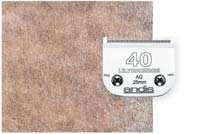
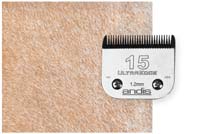
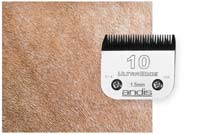
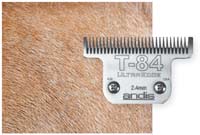
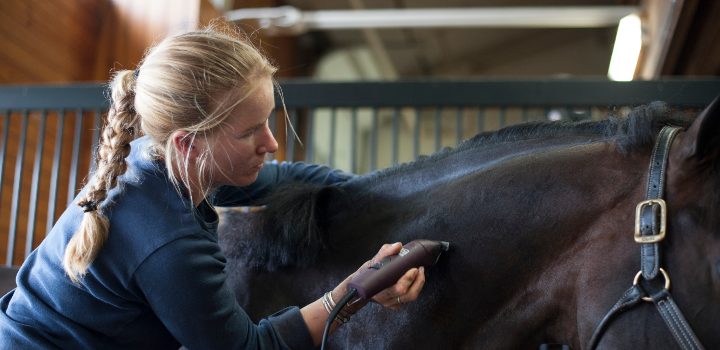
Caring for Your Blades
It’s important to take proper care of your blades so that each time you clip your horse, you will have a good end result. To ensure that they stay cool and running smoothly, keep them clean and well oiled. Always oil your blades before using, with one or two drops of oil on the tooth edge of the blade. Wipe away excess oil, to avoid it getting on your horse’s coat. Any time you wash or cool down your blade, re-oil your blades to keep them running smoothly, and from rusting when you put them away.
Apply coolant sprays before your blades get warm or too hot. Coolants will help prevent, or prolong how long you can clip, before the blade will get too hot. To make sure your blade is cool enough to use, and won’t cause your horse discomfort, touch the blade to the back of your hand. If uncomfortable to touch your skin - you will need to apply a coolant or switch to another blade before continuing to clip.
Blade Washes and sprays help remove hair, dirt and dust easily when your blades become dirty. Some washes come in plastic containers that you simply place the blade in the liquid while running, or in sprays. Both will clean and protect all in one treatment. Cleaning sprays are also popular and help to dislodge hair and dirt from the blades, while also disinfecting, cleaning and helping to cool.
You also want to have your clipper blades sharpened or replaced regularly if you use them often. Dull blades can catch hair and tug on the skin, as well as leave lines or unevenness in the coat where you clipped. You can send blades out to be sharpened professionally, search for a local sharpener (many knife sharpeners will take clipper blades) or get a kit to use at home. Do note that not all blades are able to be re-sharpened due to the materials they are made and coated with, so check if your blades can be sharpened.
You can expect to be able to re-sharpen blades 3-4 times, eventually needing to replace blades that are not able to be re-sharpened. How long your blades will last and then need to be sharpened is dependent upon how often they are used, and the condition of the horse’s coats being clipped. Sand, dirt, and thick coats over time will dull even the sharpest and strongest blades.
Shop Blade Lubricants and Accessories Back To Top↑
How to Clip your Horse
Before Clipping
Before clipping, there are a few things in you can do to make the process easier for both you and your horse. First, you should bathe and dry your horse the day before, to remove blade-dulling dirt and dust. If you’re not able to wash and dry your horse – give him a good grooming beforehand. Also, never clip your horse when he’s wet, as a clean, dry coat will cut more evenly.
Consider wearing clothing that you won’t mind getting dirty - as most people who clip horses end up covered in hair, dust, as well as cleaning and cooling products. Also tie back any long hair, and make sure you have good air movement and ventilation.
Setting up your clipping area will help your horse be calm and comfortable, as well as make the job go faster. You should be able to move easily around your horse and move out of your horse’s way if they are uncomfortable. Areas such as a quiet aisle or grooming stall often help eliminate distractions that are common at the barn. Consider your lighting, as you want to be able to see your work. Some horses also may enjoy a hay net to give them something else to do while being clipped.
Plan for a few hours to body clip a horse fully. If you haven’t clipped a horse before, allow yourself even more time to learn and get the job done. Smaller trimming jobs and trace clips will take less time and may take an hour or less to complete.
Helpful Clipping Tips and Tricks:
- Have a soft or long-bristled brush to sweep hair out of the clipper blades
- Use chalk for outlining patterns or trace clips, helping to keep your pattern even on both sides of your horse
- Blade oil, blade coolants and blade washes make clipping faster, and protect your clippers and blades
- Purchase multiple blades – having new and extra blades make it possible to switch when a blade is getting too hot or not cutting well, allowing you to finish your job- no matter what happens!
- Have a step stool handy as it can help reduce arm strain and lets you easily see what you are clipping
- Sometimes ear plugs can be helpful to horses who are noise sensitive
- Some horses need reassurance and having another person available to hold them instead of being tied can help make them more accepting of being clipped
Introducing a Horse to Clippers
Some horses have been clipped before and are unconcerned, while others may need to be introduced or reintroduced to the process. Always start your clippers running on the slowest speed you can, allowing the horse to get used to the noise gradually. Utilize a helper who can hold your horse if it he is uncomfortable while being tied/on crossties.
Where do I start? An area like the shoulder allows your horse to get acclimated to the vibration of the clipper before going onto a more sensitive area, like the face, ears, or flank. Once your horse is comfortable, move onto areas like the barrel, girth and legs.
Breaks can be helpful to give both the horse and person clipping some rest! Be aware of a horse who is anxious, moving away, or shifting weight and lifting their legs often. These maybe signs that the horse is uncomfortable and may need a break or a different approach. Every horse responds differently to being clipped, and with patience and time, can learn to tolerate having it done.
Keeping blades, washes, and cords away from your horse’s legs helps keep everyone safe and items from being stepped on. You will want to minimize the chance that you will spook or scare your horse while being clipped, to help make the experience positive.
Try to give yourself enough time before a show or event to get your horse used to being clipped, and then be able to finish your clipping job. With practice, your skills will improve, and the more that you are able to clip, the better your finished results will be.
Clipping your Horse
When clipping your horse, plan to clip in a grid like pattern. If you are doing a trace clip or a full body clip, try to start your clipping paths or areas as low on the horse’s body as possible. This will allow you to keep even pressure and have a better finished result.
Do I clip with the direction of the horse’s coat or against it? It is recommended to clip against the coat, or in the opposite direction that the hair grows. This will give you a closer cut and will allow you to easily eliminate “lines” or hair that is unevenly cut.
You often will need to gently pull the horse’s skin taunt or hold wrinkles flat to help get an even cut. Places on the horse’s body like the elbows, chest, and throatlatch are areas you may nick or accidently cut your horse, so be careful of wrinkles in these areas.
Areas like the mane and tail are also common areas that can be confusing to clip but are easy with a few simple tricks. For clipping around the tail, clip upwards making a triangle at the base of the tail, leaving a tidy and clipped tail head. When clipping the hair around the mane, avoid running your clippers horizontally below the horse’s neck crest. To avoid lines, and stray hairs sticking up, hold the clippers at a perpendicular angel, and clip downwards against the hair.
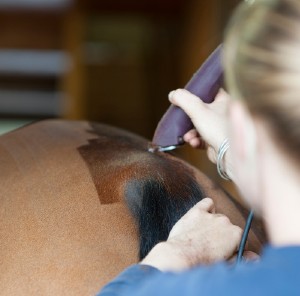
I clipped my horse, why can I see lines where I clipped? Clipper lines, or uneven hair where you clipped, is a common problem. Lines in the coat can be caused by a variety of issues, such as dull blades, uneven pressure, or a coat that was not clean enough when you started. One way to prevent lines is to slightly overlap your clipping path or pattern and keep even pressure as you clip. If you have put lines into the coat, you can re-clip over the line in an “X” shape to help clip the hairs that were unevenly clipped initially.
After Clipping
When done, either brush your horse thoroughly or give him a bath. Some horses may get hives or rashes from the hair or clipping oil/wash products, so it is recommended to bathe the horse afterwards (and even if your horse doesn’t have sensitive skin to those products, a bath is a great way to ensure all itchy, loose hair is removed and for you to admire your handiwork!). In winter when you’re not able to always able to wash your horse, hot toweling, steaming your horse’s coat with a towel, is also another technique that can help remove any oils and clipped hair.
Some horse’s coats can look dull or not the same color when finished, and this is expected. You can bring shine and gloss back to your horse’s coat quickly with shine and conditioning products, when combined with your regular grooming routine. And of course, we recommend giving your horse a treat or reward for cooperating.
How often do I need to reclip my horse? It depends on your horse’s hair growth and why you clipped your horse to begin with. Horses that are being body clipped year-round for the show ring are often clipped every 2-6 weeks depending on their individual coat growth and maintenance needs. Horses being trace clipped or spot clipped short term can be re-clipped when the hair starts to grow long and is making sweat and body heat regulation not as effective. If clipping your horse only for the winter and wanting to let the horse grow out their coat for spring, it is best to not clip your horse after he starts to grow in his spring coat, which could be anytime between February and March or even later for some horses.
Remember if you have clipped your horse, some normal care and maintenance may need to be adjusted. If blanketing your clipped horse – make sure to check blanket fit often for rubs, as the horse will have less hair to protect their skin. Blanketing accessories such as rub guards can be helpful.
Whether you trace clip, full body clip, or just tidy up with a trim, clipping your horse can be done well and can benefit your horse’s overall health and wellbeing. Remember to evaluate if clipping is right for your horse, and then choose the best clippers, blades, and blade accessories for the job.
